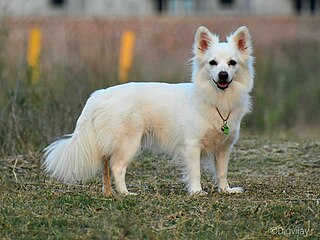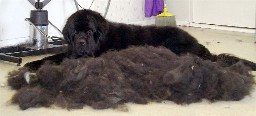
Santa's Little Helper is a fictional dog in the American animated television series The Simpsons. He is the pet greyhound of the Simpson family. He was previously voiced by Frank Welker, and is currently voiced by Dan Castellaneta. The dog was introduced in the first episode of the show, the 1989 Christmas special "Simpsons Roasting on an Open Fire", in which his owner abandons him for finishing last in a greyhound race. Homer Simpson and his son Bart, who are at the race track in hope of winning some money for Christmas presents, see this and decide to adopt the dog.

The Irish Terrier is a dog breed from Ireland, one of many breeds of terrier. The Irish Terrier is considered one of the oldest terrier breeds. The Dublin dog show in 1873 was the first to provide a separate class for Irish Terriers. By the 1880s, Irish Terriers were the fourth most popular breed in Great Britain and Ireland.

A dog park is a park for dogs to exercise and play off-leash in a controlled environment under the supervision of their owners.

A therapy dog is a dog that is trained to provide affection, comfort and support to people, often in settings such as hospitals, retirement homes, nursing homes, schools, libraries, hospices, or disaster areas. In contrast to assistance dogs, which are trained to assist specific patients with their day-to-day physical needs, therapy dogs are trained to interact with all kinds of people, not just their handlers.

Dog communication is the transfer of information between dogs, as well as between dogs and humans. Behaviors associated with dog communication are categorized into visual and vocal. Visual communication includes mouth shape and head position, licking and sniffing, ear and tail positioning, eye gaze, facial expression, and body posture. Dog vocalizations, or auditory communication, can include barks, growls, howls, whines and whimpers, screams, pants and sighs. Dogs also communicate via gustatory communication, utilizing scent and pheromones.
A dog collar is a piece of material put around the neck of a dog. A collar may be used for restraint, identification, fashion, protection, or training. Identification tags and medical information are often placed on dog collars. Collars are often used in conjunction with a leash for restraining a dog. Collars can be traumatic to the trachea if the dog pulls against the restraint of the leash, causing severe pressure to the neck. Use of a harness instead of a collar may be beneficial for dogs prone to tracheitis or those with a collapsed trachea. Conversely, dog breeds with slender necks or smaller heads may easily slip out of collars that are too loose. This can be avoided by using a martingale dog collar which tightens to distribute pressure around the neck when training the dog not to pull. Any style of dog collar must be properly fitted to ensure safety and collars should not be worn when the dog is unattended.

The Boykin Spaniel is a medium-sized breed of dog, a Spaniel bred for hunting wild turkeys and ducks in the Wateree River Swamp of South Carolina, in the United States. It is the state dog of South Carolina, where it was discovered and further developed by hunters in the early through mid 1900s. September 1 is Boykin Spaniel Day in South Carolina, originally established in 1984.

Dog meat is the flesh and other edible parts derived from dogs. Historically human consumption of dog meat has been recorded in many parts of the world.

The Indian Spitz is a spitz dog breed belonging to the utility group. The Indian Spitz was one of the most popular dogs in India in the 1980s and 1990s when India's import rules made it difficult to import dogs of other breeds.

The dog is a domesticated descendant of the wolf. Also called the domestic dog, it was domesticated from an extinct population of Pleistocene wolves over 14,000 years ago. The dog was the first species to be domesticated by humans. Experts estimate that hunter-gatherers domesticated dogs more than 15,000 years ago, which was before the development of agriculture. Due to their long association with humans, dogs have expanded to a large number of domestic individuals and gained the ability to thrive on a starch-rich diet that would be inadequate for other canids.

Cats communicate for a variety of reasons, including to show happiness, express anger, solicit attention, and observe potential prey. Additionally, they collaborate, play, and share resources. When cats communicate with humans, they do so to get what they need or want, such as food, water, attention, or play. As such, cat communication methods have been significantly altered by domestication. Studies have shown that domestic cats tend to meow much more than feral cats. They rarely meow to communicate with fellow cats or other animals. Cats can socialize with each other and are known to form "social ladders," where a dominant cat is leading a few lesser cats. This is common in multi-cat households.

Cat behavior encompasses the actions and reactions displayed by a cat in response to various stimuli and events. Cat behavior includes body language, elimination habits, aggression, play, communication, hunting, grooming, urine marking, and face rubbing. It varies among individuals, colonies, and breeds.

Hotel for Dogs is a 2009 American family comedy film directed by Thor Freudenthal in his directorial debut, and based on the 1971 novel of the same name by Lois Duncan. Starring Jake T. Austin, Emma Roberts, Kyla Pratt, Lisa Kudrow, Kevin Dillon and Don Cheadle, the film tells the story of two orphaned siblings, who secretly take in stray dogs along with their family dog at a vacant hotel.

Dog grooming refers to the hygienic care of a dog, a process by which a dog's physical appearance is enhanced for showing or other types of competition. A dog groomer is a professional that is responsible for maintaining a dog’s hygiene and appearance by offering services such as bathing, brushing, hair trimming, nail clipping and ear cleaning.

The Pug is a breed of dog with the physically distinctive features of a wrinkly, short-muzzled face, and curled tail. An ancient breed, with roots dating back to 400 B.C., they have a fine, glossy coat that comes in a variety of colors, most often fawn or black, and a compact, square body with well developed and thick muscles all over the body.

The Indian pariah dog, also known as the Indian native dog, INDog, Nadan,South Asian pye dog, Desi Kutta, and Neri Kutta, is a landrace of dog native to the Indian subcontinent. They have erect ears, a wedge-shaped head, and a curved tail. It is easily trainable and often used as a guard dog and police dog. This dog is an example of an ancient group of dog known as pye-dogs. There is archaeological evidence that the dog was present in Indian villages as early as 4,500 years ago.

Human–canine bonding is the relationship between dogs and humans. This relationship can be traced back to at least 15,000 years ago, to the Bonn-Oberkassel dog, who was found buried alongside two humans. For centuries, dogs have been considered man's best friend. This is most evident in Western countries, such as the United States, where 44% of households have a pet dog.

Dog fashion is a popular style or practice, especially in canine clothing and accessories. Dog fashion is a distinctive trend of the style in which people dress their canine companions. This trend dates back to the Egyptian predynastic period and has since expanded due to increased consumer capitalism. Other animals such as cats may also wear fashion.

The Fox Chase is an Oswald the Lucky Rabbit short released on June 25, 1928.

Food products and household items commonly handled by humans can be toxic to dogs. The symptoms can range from simple irritation to digestion issues, behavioral changes, and even death. The categories of common items ingested by dogs include food products, human medication, household detergents, indoor and outdoor toxic plants, and rat poison.



















